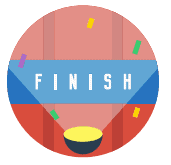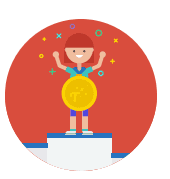Introduction
Why your loyalty program is failing – but can still be fixed.
Building customer loyalty is — and has to be — the primary focus of every business. Loyal customers spend more per purchase, visit more frequently, and are the number one source of new referrals. In fact, loyalty represents a business’s single most lasting and protectable asset to monetize for years to come. It’s shocking that we continue to see customer loyalty programs completely fall on their face. The average consumer holds close to 30 loyalty program memberships but is actively engaged in only 10. After the first year, 58% of loyalty memberships are inactive. So why do the preponderance of customer loyalty programs continue to fail at engaging consumers?
What have the select few companies who’ve succeeded in loyalty — Starbucks, Walgreens, Starwood Hotels, and Delta Airlines to name a few — done differently to succeed? That’s exactly what we’ve dedicated our company to figure out. In this action-packed guide, we’ll introduce you to the loyalty race track — our simple analogy for understanding exactly what merchants are doing wrong in their customer loyalty program, and what they should do instead to effectively build and maintain long-term customer loyalty. Because the race for customer loyalty is both a marathon and a sprint.
The impact of churn for today’s businesses’ loyalty programs
In the restaurant and retail world, executives live and die on same-store sales growth, the single most important metric for evaluating the health of a multi-location business. The task is easy in the early years of a new concept, but long-term perpetual growth is hard. And even after achieving an “up” year, the reward is just more pressure to do it all over again. No wonder many operators (especially those under the scrutiny of public markets) describe the same-store sales challenge as a hamster wheel. It’s a marathon without a water break. Figuring out how to get each of the millions of customers who walk in the front door every day to spend 4% more next year may feel slightly insane.
Of course, it’s insane! No business has ever succeeded in getting all their customers to do the same thing. Shrewd operators focus instead on specific groups of customers — it’s the reason marketers target precise demographics and why menus offer a diversity of items to choose from.
It’s seven times more expensive to acquire a new customer than to encourage an incremental visit from an existing customer.
According to the 2016 Customer Loyalty Benchmarks study, 64% of revenue comes from just the top quartile of customers; a focus on your highest-value loyalists is the only way to make the ongoing same-store sales growth achievable (e.g., it takes a mere 6.25% increase from your top quartile of customers — those who are already most loyal — to achieve the same result as 4% growth from all customers). Not only are your VIPs the highest-value customers, they are actually responsive to your marketing — it’s seven times more expensive to acquire a new customer than to encourage an incremental visit from an existing customer. This is why successful brands invest so heavily in customer loyalty — the math is irrefutable.
Unfortunately, heavy investment does not guarantee the desired result, as nearly 6 out of 10 restaurant and retail loyalty memberships are inactive — almost all within the first year. So merchants are giving out more than $50 billion in rewards each year and consumers aren’t holding up their end of the bargain.
Your loyalty program as an Olympic race track
There’s one simple analogy that describes the consumer experience as part of a loyalty program: running a race around a track. They have to run around the track (make purchases), and only when they make it to the finish line do they earn a reward. Some customers naturally will never make it to the finish line because they weren’t dedicated. But most are running the race (making repeat purchases) with the finish line (reward) in their sights.
Traditional loyalty programs like punch cards and rewards cards fail because they put hurdles all the way around the race track. Forgot your plastic card at home? Oops, you’re out of the race. Have to remember to print out a coupon? Sorry, that’ll trip you up. Concerned about the privacy implications of giving out your phone number? Or just in too much of a hurry to bother? Do not pass “Go,” do not collect $200. Frankly, it’s no wonder churn is so high — modern consumers demand effortless experiences and most loyalty programs are anything but.
Some businesses attempt to justify their loyalty program breakage with incredibly flawed logic: “We need to have a loyalty program, but we don’t actually want to give out too many rewards, so it’s good that some people are churning out.” This is a missed opportunity for three reasons:
Revenue
First, you actually want your best customers to make it to the finish line. Just like an Olympic runner accelerates on the final 100 meters, when your customers are nearing a reward, they “run” significantly faster. At Thanx, we’ve measured up to 60 percent increases in visit frequency on the final two transactions (the homestretch) leading up to a reward.
More revenue
Second, you actually want those rewards to be redeemed; customers redeeming rewards via Thanx spent ~15 percent more on that transaction than their historical average ticket — an overspend that in many cases actually pays for the entire cost of the reward.
Even more revenue
And finally, recent reward recipients are 2.3x — 4.3x more likely to refer a new customer on their victory lap immediately after earning a reward. Referrals from promoters generally result in 3–5x higher customer lifetime values.
The takeaway? There is a massive financial advantage to encouraging customers to complete the loyalty race.
Why are consumers churning out of loyalty programs?
Sticking with the track analogy (we’ve come too far to quit now), a few actionable takeaways for modern marketers follow.
Make it easy to get out of the starting blocks

In every race, a strong start can mean the difference between winning and losing. Those first few steps are mission critical. In a loyalty program, every consumer needs to enroll in order to start the race — so don’t make this experience painful. For instance, CurrentC — the Apple Pay competitor promoted by Walmart and a broader consortium of retailers — requires 15 unique pieces of customer data in order to complete your account. By the time you’re asking a consumer for their “driver’s license number” and “anniversary date” as required fields, you can be sure you have lost a fair number of participants before their race even started. Loyalty enrollment must be simple and must be able to be completed on a consumer’s mobile device, not a paper signup form.
Eliminate the hurdles all the way around the track

For consumers, 90% of the loyalty experience is accrual — the transactions made in order to earn a reward — and just 10% of the experience is redemption, where consumers finally receive a reward. Therefore, for the vast majority of the loyalty race, the only incentive is a finish line out in the distance — there is no instant gratification. Because we as consumers are lazy and notoriously bad at optimizing for the future, it’s no wonder many of us stop running a race when we constantly encounter hurdles (fun fact: the world record for the 100-meter dash is 23% faster than the world record for the equivalent distance with hurdles). Every time they have to open an app and check-in on their phone, every time they walk into a store and have to interact with a tablet, every time they have to type in a phone number or email at the point of sale, every time they have to scan a QR code or take a picture of a receipt, your customers consider giving up the loyalty race. If consumers have to do anything extra before, during or after their purchases, they will eventually run out of steam. Loyalty engagement must be effortless for consumers to keep running.
Keep the finish line well lit

It’s a truly remarkable phenomenon to watch long-distance runners round the homestretch and shift into a new gear. With the finish line in sight, they tap into previously unknown energy reserves and start sprinting full-speed. Now, imagine if those races were to run in pitch black — where those same runners would stumble across the finish line. Their times would certainly be slower because they would have never received the visual cues to kick off their closing stretch sprint. This “darkness” problem is common in loyalty programs, many of which make it very hard to know how close you are to your next reward. For instance, at CVS the consumer is prompted for their phone number to participate in the loyalty program — sometimes the point of sale spits out dozens of valuable coupons, and sometimes nothing happens at all. It makes it very hard to change a consumer’s behavior if she has no idea whether and when she will benefit. Loyalty progress must be transparent to see customers run at full speed.
Ensure the race is the correct distance

100M world record holder Usain Bolt is one of the most elite athletes on the planet. But faced with the challenge of an Olympic marathon, it’s unlikely Bolt would waste his energy — that’s not a challenge he can win so it’s not worth his energy. The same is true with the structure of your loyalty program and your customers — certainly you don’t want it to be too easy for them to complete laps around the track, but a program that feels impossible to achieve will result in dramatically fewer consumers even bothering to put on their race bibs in the first place. If your top 25% of customers cannot earn a reward on a reasonable timeline for your business, the program is too conservative. Loyalty accrual must be attainable to ensure customers deem it worth their time.
Make sure the medal is big enough

The Nike Women’s Marathon is one of the most oversubscribed races in the country every year (more than 25K runners — and sadly, no longer in San Francisco). Why? Because the reward for completing the race is a custom piece of jewelry from Tiffany’s delivered by a tuxedo-clad firefighter. There’s no denying the obvious: bigger rewards lead to far greater consumer engagement. Even more, unsatisfactory rewards are actually demotivating to loyal customers who don’t feel sufficiently valued by the brand (the Overjustification Effect in psychology lingo). Loyalty incentives must be sufficiently motivating to see customers stick with the race over time (or enter it at all.)
Wrap up
Best in class loyalty programs are simple, effortless, transparent, attainable, and motivating. Hit all five of these goals and you’ll see more customers crossing the finish line and blow by your same-store sales targets for next year.